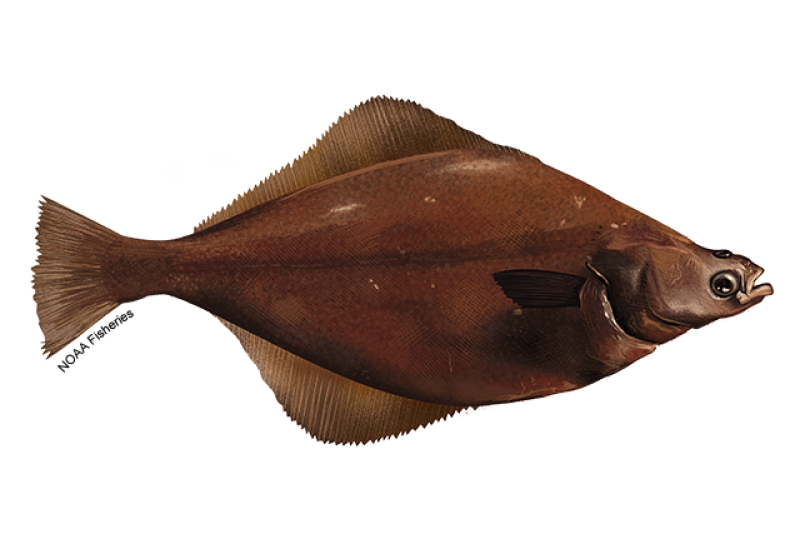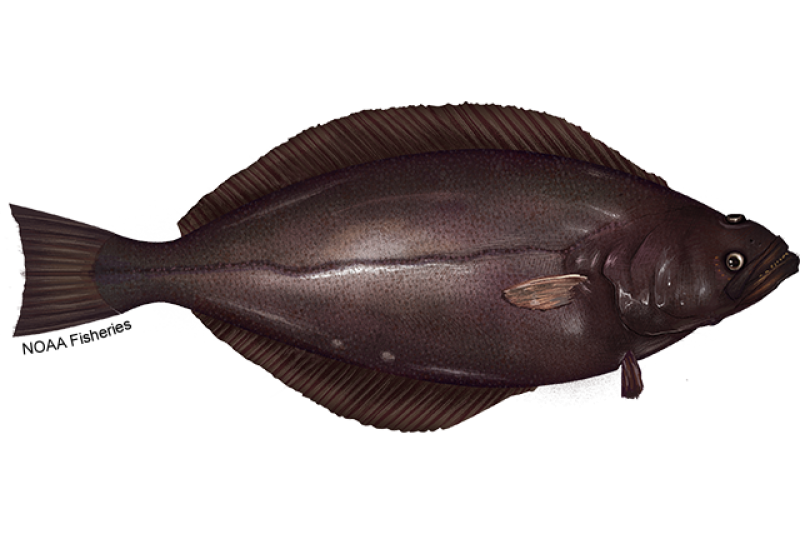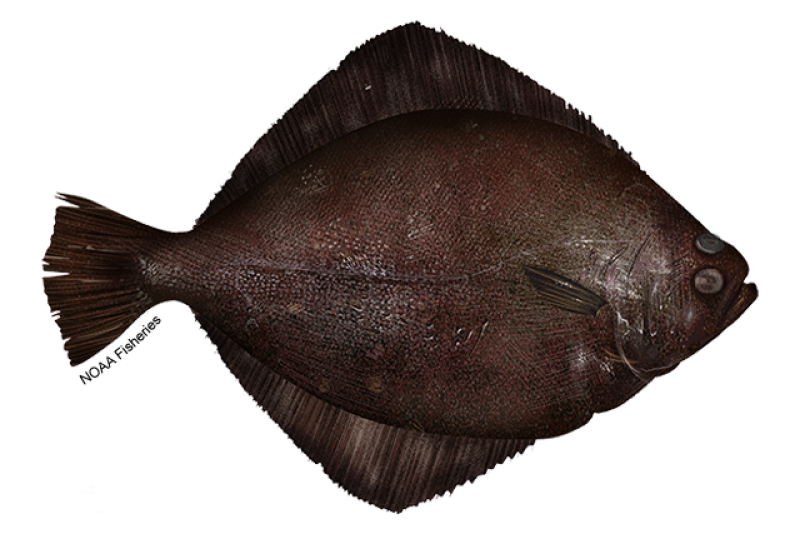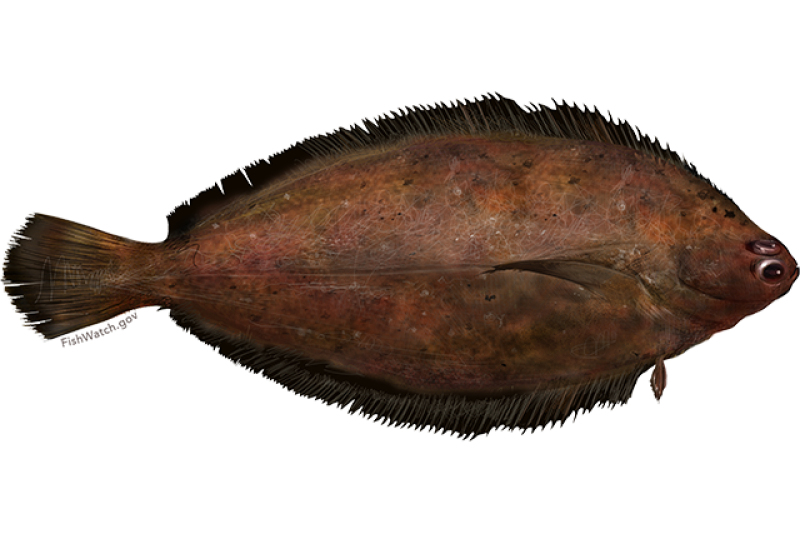 English sole flatfish. Credit: NOAA Fisheries
English sole flatfish. Credit: NOAA Fisheries
English sole flatfish. Credit: NOAA Fisheries
About the Species
 English sole flatfish. Credit: NOAA Fisheries
English sole flatfish. Credit: NOAA Fisheries
English sole flatfish. Credit: NOAA Fisheries
U.S. wild-caught English sole is a smart seafood choice because it is sustainably managed and responsibly harvested under U.S. regulations.

Population
The Pacific Coast stock is not overfished.

Fishing Rate
Not subject to overfishing.

Habitat Impact
Area closures and gear restrictions protect habitats affected by bottom trawls used to harvest English sole.

Bycatch
Regulations are in place to minimize bycatch.
Population Status
- There are three stocks of English sole: Pacific coast, one stock contained in a stock complex in the Gulf of Alaska Shallow Water Flatfish Complex, and one stock contained in the Bering Sea/Aleutian Islands Other Flatfish Complex. According to the most recent stock assessments:
- The Pacific coast stock is not overfished (2013 stock assessment) and not subject to overfishing based on 2022 catch data. Summary stock assessment information can be found on Stock SMART.
- English sole is managed as part of the Gulf of Alaska Shallow Water Flatfish Complex, but has not been assessed. The complex is not overfished based on the stock assessment of Northern rock sole - Central Gulf of Alaska (2021 stock assessment), Northern rock sole - Western Gulf of Alaska (2021 stock assessment), rock sole - Central Gulf of Alaska (2021 stock assessment), and rock sole - Western Gulf of Alaska (2021 stock assessment) which are regarded as the primary indicator species in this complex. The stock complex is not subject to overfishing based on 2023 catch data. Summary stock assessment information for Northern rock sole - Central Gulf of Alaska can be found on Stock SMART, Northern rock sole - Western Gulf of Alaska can be found on Stock SMART, rock sole - Central Gulf of Alaska can be found on Stock SMART, and rock sole - Western Gulf of Alaska can be found on Stock SMART.
- English sole is managed as part of the Bering Sea/Aleutian Islands Other Flatfish Complex and has not been assessed so the population status is unknown. This complex is not subject to overfishing based on 2023 catch data.
Appearance
- English sole are flatfish, with both of their eyes located on the right side of their head.
- They have a pointed snout and their upper eye is visible on their underside.
Biology
- Female English sole grow twice as large as males, up to about 2 feet.
- Females can live for more than 20 years, 4 years longer than males.
- Males are able to reproduce when they reach 2 years old. Females mature starting at 3 years old.
- They spawn from winter to early spring over soft muddy ocean floors in water 165 to 230 feet deep.
- Depending on their size, females release between 150,000 and 2 million eggs. Eggs sink to the bottom a few days after spawning.
- Larvae stay near the surface for about 2 to 3 months before they are transported by wind and tidal streams to nearshore and estuarine nursery areas—an uncommon characteristic for a flatfish species in this region.
- Juveniles spend 1 to 2 years developing in nursery areas before migrating out to deeper waters, typically in late May.
- Larvae feed on plankton (tiny floating plants and animals).
- Juvenile and adult English sole feed on crustaceans, worms, small bivalves, clam siphons, and other bottom-dwelling invertebrates.
- English sole feed during the day using sight and smell, and sometimes dig for their prey.
- Seabirds, larger fishes, and marine mammals prey on juveniles. Marine mammals, sharks, and other large fish prey on adults.
Where They Live
Range
- English sole are found off the west coast of North America from the Bering Sea and Aleutian Islands to central Baja California.
Habitat
- Larval and juvenile English sole live in estuaries and nearshore areas, including Puget Sound and the Strait of Georgia.
- Adults live in water more than 1,800 feet deep.
- Juveniles and adults prefer soft sandy or muddy ocean bottom habitats, but have also been found in eelgrass habitats.
- After spawning in the spring, English sole travel north to summer feeding grounds. They return south in the fall.
Fishery Management
- NOAA Fisheries and the Pacific Fishery Management Council manage the English sole fishery on the West Coast.
- Managed under the Pacific Coast Groundfish Fishery Management Plan:
- Limits on the number of permits and fishermen allowed.
- Limits on the minimum size of fish that may be harvested.
- Limit on how much may be harvested in one fishing trip.
- Certain seasons and areas are closed to fishing.
- Gear restrictions help reduce bycatch and impacts on habitat.
- A trawl rationalization catch share program includes:
- Catch limits based on the health of each fish stock and divided into shares that are allocated to individual fishermen or groups.
- These fishermen can decide how and when to catch their share – preferably when weather, markets, and business conditions are most favorable, allowing the fishery the flexibility to be more environmentally responsible, safer, more efficient, and more valuable.
- NOAA Fisheries and the North Pacific Fishery Management Council manage the English sole fishery in Alaska.
- Managed under the Fishery Management Plan for Groundfish in the Gulf of Alaska:
- There is no directed fishery for English sole, and only minor amounts are landed incidentally in other fisheries.
- Managed under the Fishery Management Plan for Groundfish of the Bering Sea and Aleutian Islands:
- Fishermen must have a permit to participate in these fisheries, and the number of permits is limited to control the amount of fishing.
- Non-pelagic trawl gear used in directed flatfish fisheries in the Bering Sea is required to be modified to raise portions of the gear off the sea floor.
- There is no directed fishery for English sole, but managers set total allowable catch levels for the flatfish complex that contains English sole.
Harvest
- In 2022, commercial landings of English sole totaled 270,000 pounds and were valued at $45,000, according to the NOAA Fisheries commercial fishing landings database.
- The majority of the catch comes from Oregon and Alaska.
- Gear types, habitat impacts, and bycatch:
- Bottom trawls are used to catch English sole.
- Trawls that are used to harvest English sole can contact the ocean floor and impact habitats, depending on the characteristics of the ocean bottom and the size of the gear.
- Bottom trawls cause minimal damage to habitat when targeting English sole over soft, sandy, or muddy ocean bottoms on the West Coast and in Alaska.
- In Alaska and on the West Coast, NOAA Fisheries and the regional fishery management councils have implemented large closed areas to protect sensitive rocky, cold-water coral and sponge habitats from bottom trawls.
- Vessel monitoring systems allow enforcement staff and fishery managers to monitor GPS locations of fishing activities to ensure vessels are complying with closed areas.
- In Alaska, fishery managers limit the amount of halibut, herring, and crab that groundfish fisheries can incidentally catch. If the limit is reached, managers close the fishery for the remainder of the season.
Scientific Classification
- English sole are found off the west coast of North America from the Bering Sea and Aleutian Islands to central Baja California.
- Larval and juvenile English sole live in estuaries and nearshore areas, including Puget Sound and the Strait of Georgia.
- Adults live in water more than 1,800 feet deep.
- Juveniles and adults prefer soft sandy or muddy ocean bottom habitats, but have also been found in eelgrass habitats.
- After spawning in the spring, English sole travel north to summer feeding grounds. They return south in the fall.
Fishery Management
- NOAA Fisheries and the Pacific Fishery Management Council manage the English sole fishery on the West Coast.
- Managed under the Pacific Coast Groundfish Fishery Management Plan:
- Limits on the number of permits and fishermen allowed.
- Limits on the minimum size of fish that may be harvested.
- Limit on how much may be harvested in one fishing trip.
- Certain seasons and areas are closed to fishing.
- Gear restrictions help reduce bycatch and impacts on habitat.
- A trawl rationalization catch share program includes:
- Catch limits based on the health of each fish stock and divided into shares that are allocated to individual fishermen or groups.
- These fishermen can decide how and when to catch their share – preferably when weather, markets, and business conditions are most favorable, allowing the fishery the flexibility to be more environmentally responsible, safer, more efficient, and more valuable.
- NOAA Fisheries and the North Pacific Fishery Management Council manage the English sole fishery in Alaska.
- Managed under the Fishery Management Plan for Groundfish in the Gulf of Alaska:
- There is no directed fishery for English sole, and only minor amounts are landed incidentally in other fisheries.
- Managed under the Fishery Management Plan for Groundfish of the Bering Sea and Aleutian Islands:
- Fishermen must have a permit to participate in these fisheries, and the number of permits is limited to control the amount of fishing.
- Non-pelagic trawl gear used in directed flatfish fisheries in the Bering Sea is required to be modified to raise portions of the gear off the sea floor.
- There is no directed fishery for English sole, but managers set total allowable catch levels for the flatfish complex that contains English sole.
Harvest
- In 2022, commercial landings of English sole totaled 270,000 pounds and were valued at $45,000, according to the NOAA Fisheries commercial fishing landings database.
- The majority of the catch comes from Oregon and Alaska.
- Gear types, habitat impacts, and bycatch:
- Bottom trawls are used to catch English sole.
- Trawls that are used to harvest English sole can contact the ocean floor and impact habitats, depending on the characteristics of the ocean bottom and the size of the gear.
- Bottom trawls cause minimal damage to habitat when targeting English sole over soft, sandy, or muddy ocean bottoms on the West Coast and in Alaska.
- In Alaska and on the West Coast, NOAA Fisheries and the regional fishery management councils have implemented large closed areas to protect sensitive rocky, cold-water coral and sponge habitats from bottom trawls.
- Vessel monitoring systems allow enforcement staff and fishery managers to monitor GPS locations of fishing activities to ensure vessels are complying with closed areas.
- In Alaska, fishery managers limit the amount of halibut, herring, and crab that groundfish fisheries can incidentally catch. If the limit is reached, managers close the fishery for the remainder of the season.
Scientific Classification
| Kingdom | Animalia | Phylum | Chordata | Class | Actinopterygii | Order | Pleuronectiformes | Family | Pleuronectidae | Genus | Parophrys | Species | vetulus |
|---|
Last updated by NOAA Fisheries on 03/21/2025
Featured News
 Offloading frozen Pacific cod from a catcher-processor vessel in Dutch Harbor, Alaska. Credit: NOAA Fisheries / Paul Hillman.
Offloading frozen Pacific cod from a catcher-processor vessel in Dutch Harbor, Alaska. Credit: NOAA Fisheries / Paul Hillman.
Economic Snapshot Shows Alaska Seafood Industry Suffered $1.8 Billion Loss 2022–2023
Seafood Facts

Is English Sole Sustainable?
U.S. wild-caught English sole is a smart seafood choice because it is sustainably managed and responsibly harvested under U.S. regulations.
Availability
Year-round.
Source
U.S. wild-caught from Alaska to California.
Taste
Mild taste with a slight shellfish flavor.
Texture
Moist and delicate with fine flakes.
Health Benefits
Excellent source of low-fat protein as well as selenium and vitamins.
Nutrition Facts
Servings: 1; Serving Weight: 100 g (raw); Calories: 91 ; Protein: 18.84 g ; Total Fat: 1.19 g; Total Saturated Fatty Acids: 0.283 g; Carbohydrate: 0 g; Total Sugars: 0 g; Total Dietary Fiber: 0 g; Cholesterol: 48 mg; Selenium: 32.7 mcg; Sodium: 81 mgMore Information
Sole Recipes
Looking for some ways to add sole into your rotation? If you need some cooking inspiration, browse these recipes for citrus sole with tahini drizzle, sole sliders, and more!

Last updated by NOAA Fisheries on 03/21/2025
Seafood News
 Celebrate Culinary Arts Month with a sustainable seafood recipe for every month of the year.
Celebrate Culinary Arts Month with a sustainable seafood recipe for every month of the year.
What Your Birth Month Says About Your Next Seafood Recipe
 Fresh-caught taʻape on ice. Credit: Conservation International Hawaiʻi.
Fresh-caught taʻape on ice. Credit: Conservation International Hawaiʻi.
Reducing Waste and Feeding Communities in Hawaiʻi with a Whole Fish Approach
 Chef Tyler Hadfield’s Curried Skate Wings with Tomato-Masala Chutney
Chef Tyler Hadfield’s Curried Skate Wings with Tomato-Masala Chutney
Ring In the New Year With These Crowd-Favorite Seafood Recipes
 NOAA Fisheries, in collaboration with Blue Ocean Mariculture, is conducting a multi-year pilot study to evaluate observational methods and tools for studying Hawaiian monk seal behavior. Courtesy of Blue Ocean Mariculture
NOAA Fisheries, in collaboration with Blue Ocean Mariculture, is conducting a multi-year pilot study to evaluate observational methods and tools for studying Hawaiian monk seal behavior. Courtesy of Blue Ocean Mariculture





